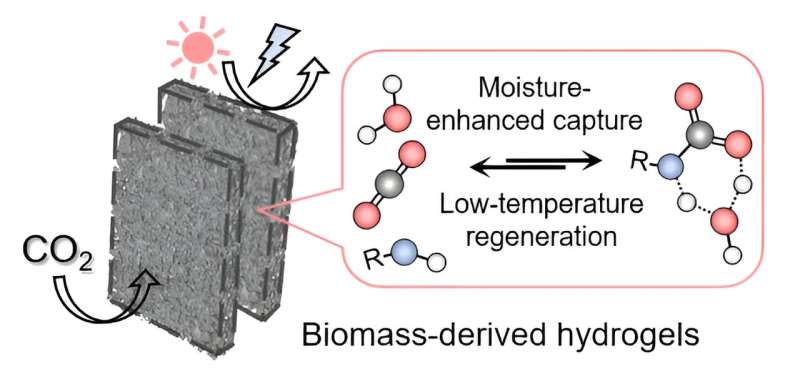August 17, 2023 dialog
This article has been reviewed according to Science X's editorial process and policies. Editors have highlighted the following attributes while ensuring the content's credibility:
fact-checked
peer-reviewed publication
trusted source
written by researcher(s)
proofread
Researchers develop a sustainable gel film to capture carbon dioxide with reduced energy cost

Global CO2 emissions for 2022 reached 36.1 gigatons, and this consumed 13–36% of the remaining carbon budget to limit warming to 1.5°C, which means our permissible emissions could be depleted within two years.
Direct air capture (DAC) technologies extract CO2 directly from the atmosphere at any location, but their practicality is limited by the higher energy needs and overall costs. In particular, most solid-sorbent-based systems cannot function well in humid conditions and have high regeneration temperatures or require vacuum conditions.
Design of sustainable carbon capture hydrogels (SCCH)
To overcome these challenges, we developed sustainable carbon-capture hydrogels (SCCH) as a step-change material for CO2 capture with high uptake and exceptionally low regeneration energy (Figure 1). The study is published in the journal Nano Letters.
In contrast to other sorbent materials where the inert water leads to energy-intensive thermal regeneration, water in hydrogels has a reduced evaporation enthalpy that can contribute to a lowered regeneration energy. The SCCH consists of low-cost biomass konjac gum, thermo-responsive cellulose, and uniformly dispersed polyethylenimine (PEI). Another advantage of this SCCH is its unique hierarchical structure. The micro- and nanoscale pores enable CO2 transport and easy access to active amine sites.

Carbon dioxide capture performance
The precaptured water vapor enhances the CO2 binding with PEI, which leads to a much higher capture capacity under humid conditions (Figure 2, left). In addition, the captured CO2 releases at a low energy supply (Figure 2, right), which can be achieved by mild electric heating or solar irradiation without vacuum, as long as the temperature reaches ~60°C. This is assisted by reduced evaporation enthalpy of water in hydrophilic hydrogels and the thermo-responsiveness of cellulose.
We also highlight another advantage of our SCCH, which is the ease of preparation. The gel can be made with commercially available materials, dissolved in water, poured into a mold, and followed by a freeze-drying process. This is scalable and durable in ambient air, which benefits practical application. With such a low regeneration temperature, our new hydrogels can be a game-changing materials platform for more sustainable air quality management and DAC technologies.
This story is part of Science X Dialog, where researchers can report findings from their published research articles. Visit this page for information about ScienceX Dialog and how to participate.
More information: Youhong Guo et al, Scalable Biomass-Derived Hydrogels for Sustainable Carbon Dioxide Capture, Nano Letters (2023). DOI: 10.1021/acs.nanolett.3c02157
Journal information: Nano Letters
Youhong Guo is a Postdoc in the Department of Chemical Engineering at Massachusetts Institute of Technology, working with Prof. T. Alan Hatton. Her research interests are developing polymer materials for applications in energy and environmental sustainability.





















